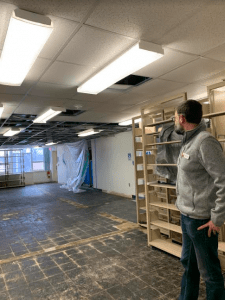Brooke Valentin Contributing Writer
In Jan., varying temperatures caused the pipes on the third floor of the Mantor Library to leak and flood the space, forcing the library to restrict access to the third floor indefinitely.
Keenan Farwell, the interim Director of Facilities and Project Manager for UMS, said the damage was fairly extensive, damaging the ceiling tiles, sheetrock walls, carpet, lights, and ventilation. He also said, “The coil, damper and the computer for the rooftop unit all failed and will need to be replaced. We also had 2 VFD [Variable Frequency Drives] fail with coils that froze and broke, causing water to run into other areas.”
Bryce Cundick, the director of Mantor Library, found the IT department to be hit particularly hard by the flooding. “There was three inches of standing water on the floor,” said Cundick. “It really hurt IT’s area more than the library’s area, but in order to get rid of all the damage to the carpet, ceiling, and the vent, they had to move everything out of half of the space up there.”
While investigating the damage, signs of asbestos were found which had to be removed promptly. Asbestos is a mineral containing fibers that can be woven into fabrics. These fibers are composed of many microscopic ‘fibrils’ that can be released into the atmosphere. When inhaled, they can aggravate and scar lung tissue. The asbestos abatement alone cost UMF around $8,000.
The third floor housed the A through E books, juvenile and young author books, IT’s offices, study spaces and the Peter Mills Electronic Classroom. Preventive measures were enacted to protect the computers and books housed on the third floor.
“All of those computers were fine, but in our effort to get all of the books away from the water, they ended up in The Peter Mills Classroom,” said Cundick. The computers in that classroom were moved to Fusion 104, previously the Mac Lab, and is now the library instruction room until the third floor is safe to enter.
Despite the significant movement of equipment and books, only two books were damaged in the flood. But as the books are currently unorganized, they are not available to students.
Farwell recalled receiving the news about the flood over winter break on Jan. 17. “7:30 Friday morning I received a call from our HVAC Tech stating that there was water pouring from the ceiling and that the rooftop heating unit had failed and a coil had frozen,” he said. “When I arrived we manually shut off the water and the heating units to the whole building to stop the water from continuing to run, and then we started removing wet ceiling tiles and extracting the carpet.”
He was incredibly grateful to everyone who helped out, as he said, “Emergencies like this are all hands on deck and I am very thankful to have a team that will drop everything and start helping in any way that is needed.”
The library will be opening areas up for use as they become available. Farwell says that the library has a specific plan for this process. “We will be trying to phase the opening of the areas,” he said. “First should be the book shelving area, to allow access to research materials and also the computer lab, then IT space should be opened, and then the remaining areas will be opened when the project is complete.” The third floor is estimated to be fully up and running in three months.
